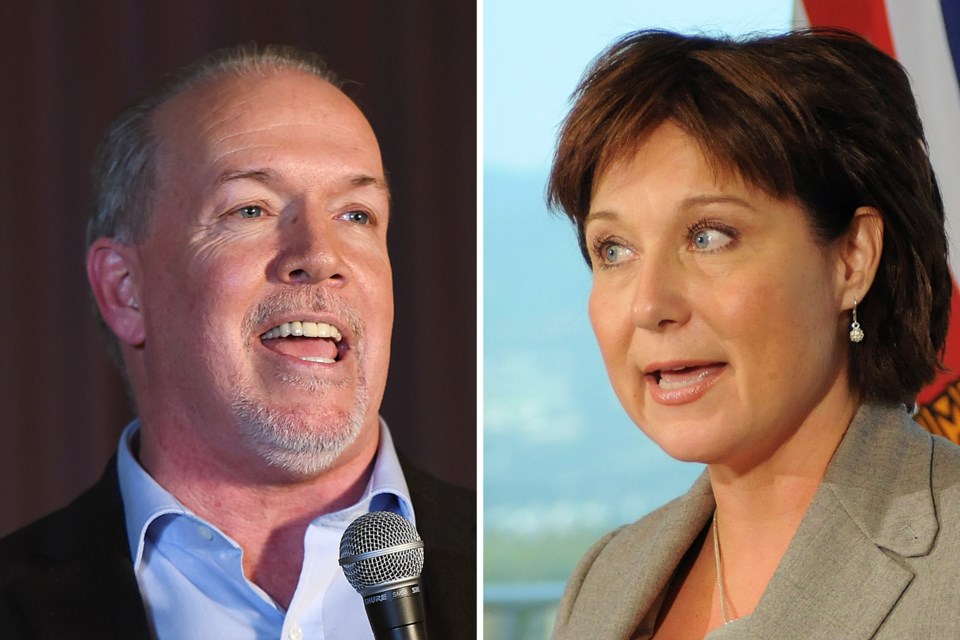For all the alarm bells it has rung over the years about runaway B.C. Liberal debt, the NDP isn’t being shy about piling on some more.
This week’s full platform release includes a warm embrace of a concept the NDP used to warn continually was getting dangerously out of control — borrowing vast sums of money to do good works around B.C.
After repeatedly highlighting that Christy Clark ran on a “debt-free B.C.” slogan but then racked up $9 billion more in debt, the NDP plans almost to match that record. The party has committed to $7 billion in capital spending, above and beyond what the Liberals have already planned over the next three years.
The Liberal government’s most recent budget includes $13.7 billion in new taxpayer-supported capital spending over the three-year plan. It’s all earmarked for completion of approved projects, plus new schools, facilities and roadwork. The budget touts it as “the highest level ever,” mostly because the federal government has increased spending in cost-shared projects, which invites/entices the province to match.
The NDP is looking at investing (borrowing) an additional $7 billion over currently budgeted capital allocations over five years ($1.4 billion per year) starting in 2018. There’s also a plan to leverage another $3 billion from partnerships with other entities. That puts the total of promised additional infrastructure spending at $10 billion.
The NDP estimates it would create 96,000 jobs. Not mentioned in the document is what it would do to the general debt picture. Liberal spending plans involve hiking the provincial debt from $66.6 billion to $77.7 billion in three years. Based on the platform, an NDP government would hike it into the $85-billion neighbourhood.
Even Finance Minister Mike de Jong, who presided over the past four years of debt buildup, has been acknowledging lately that B.C. is at the upper limit of how much it can borrow. He was quick to react this week to the NDP platform, but was so overwhelmed with fear and loathing about other aspects of the plan he didn’t devote much time to the debt.
What will likely save the NDP from much embarrassment over this about-face on debt is the fact that macro-economic policy isn’t nearly as interesting on the campaign trail as is the promise that seniors would get their free mid-week ferry rides back under the NDP. Or that MSP premiums would be eliminated, along with tolls, interest charges on student debt, and electricity and ICBC price hikes.
There are more than two dozen attractive promises in the platform. No more portable classrooms. More park rangers; $400 a year for renters; $1,000 bonuses to graduates.
The Liberals will soon start a concentrated attack on the economic implications of their opponents’ platform, keyed on the “certainty” of a credit downgrade if it were implemented. That will downplay the fact the only major crowd-pleaser in the Liberal platform is the idea of halving MSP premiums for the 50 per cent of the population that pays them.
There are two big black holes, one in each platform.
In the Liberal one is the fact that they have shorted several service areas over the past 16 years, and underfunded whole spheres of activity. It’s the downside of balancing budgets. The reason most of the Liberal platform is a recitation of past accomplishments is because setting expensive new targets would put balanced budgets at risk.
The hole in the NDP platform is the lack of any acknowledgment that an NDP government would need major new sustained revenue sources — tax increases — if it wanted to do even half of what it has been advocating in opposition for the past 16 years. It has committed to hiking taxes on high-income earners ($150,000-plus), corporations and owners of vacant real estate, for starters. That might be enough to balance a budget — once.
It would take a lot more than that to fund the rebuild of services the party has in mind.
Both sides will likely keep talking past each other on these points, because acknowledging them would derail both trains.
This is a popularity contest, not a logical-thinking exercise.
For more B.C. news go to



